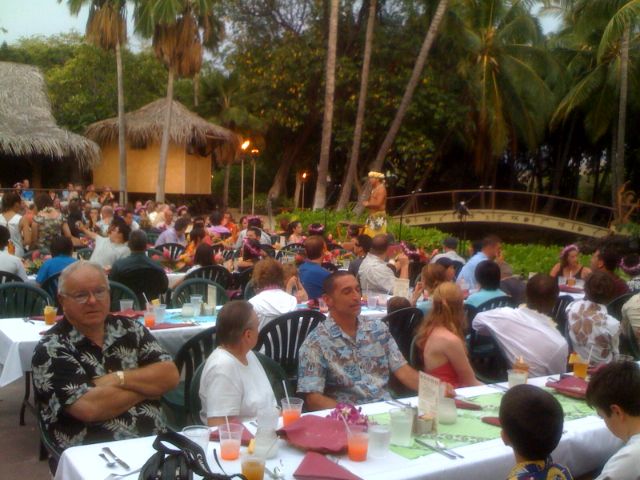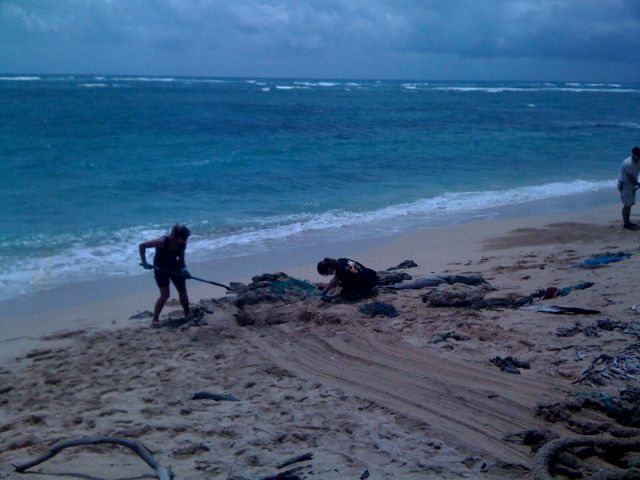Well here I am, writing on my iPhone into my edublogs site.
This is pretty impressive
I have attached 3 pics from my phone:
Beach at la’ie with NOAA digging out nets
2 pics from recent kona village vacation
cool!
Tag Archives: edtech
NECC Day 2 Ian Jukes Workshop
Day 2 – Ian Jukes
Biggest, most important idea
Think the continuum – from where we are to where we will be in 10 years – need to set a small step goal for moving towards where you need to go…
websites and boks he showed here:
http://del.icio.us/mehines/jukes
One of the important ideas Ian kept stressing was that it is critical to understand the power of exponential thinking – we have tendency to treat where we are today as what we should implement, but like a quarterback that needs to throw where a receiver is going, we need to plan for where things are going and consider this rapid change in our thinking
awesome idea – book search feature in google. Many books (including the ones I bookmarked in delicious) have previews in books.google.com. Worth looking at.
For instance the one book that Ian recommended more than any was teaching for tomorrow (Ted McCain):
http://books.google.com/books?id=oDsvkqgj_NgC&pg=PR5&dq=teach+for+tomorrow&sig=ACfU3U1i9Hg38FeUIkAP-dhcCXmct1w9Cg
The Morning:
Ian went over the 4 major exponential trends that we need to consider as we think about preparing for planning:
Moore’s Law – the trend will contune for the foreseeable future – faster, small, cheaper
Photonics – the trend will continue to increase – bandwidth triple almost yearly for the foreseeable future
Internet – its tremendous growth will continue (he didn’t particularly talk about web 3.0, but I think this should matter – the evolution of intelligent agents will be a powerful new use of the web)
Ian made the point that most teachers have never left education – they have been in the system since they were 6 years old – they have paradigm paralysis – too close to the institution to see its needs through new eyes.
He talked about the TTWADI (That’s the way we’ve always done it) mentality – used a story of conditioning monkeys in a cage (shooting them down with a water hose if they tried to grab bananas – they stop trying and will actively prevent any new ones – even if they are new to the cage – it becomes accepted practice).
Story of railroad tracks – why? Roman Chariots – why are SRBs the width they are – had to fit in the tunnels built to accommodate tracks
We talked about what are our accepted practices which are part of the TTWADI mind set – school day, textbooks, class size, teacher training, school year, grouping by age, subjects to study, etc
He made the case that in 1937 the US had the longest school year in the world, in 2008 we are at or near the bottom – longest is singapore
“When the going gets tough, the tough get traditional”
Based on trends in Moores Law, In 2019, the typical computer specs:
Memory: 208,000 GB
Hard Drive: 40 TB
Processor Speed: 1.2 THz
Price: $1.37
What does that mean? ubiquitous computing
he quoted Marc Prensky quite a bit in the presentation (in delicious link above)
Makes the case that although most of us reember before the exponetial curve took off, our kids have always lived it – they expect it
Quoted Kurzweil quite a bit (just googled – he has a ted talk here:
The book the singularity is here – recommended in delicious inks above
What will kids need to know? In answer to question about how much is too much, he kept revisiting the idea of BALANCE – need to honor botht he things that we know plus include new ways to thinking.
Mentioned a book he is planning on reading : turn it off (delicious link above)
Another BIG idea – too many things happening – whether you are an experienced tech user of a beginner – take baby steps – just pick one thing and start incorporating it – don’t over immerse (just like training – if you go too hard, you will hurt yourself and not come back).
on the topic of Photonics: Gilder: Telecosm: The world after Bandwidth abundance (delicious link above)
Talked about the emergence of wimax and wibro in the next few years
gotta go to more sessions – will add to summary later…



